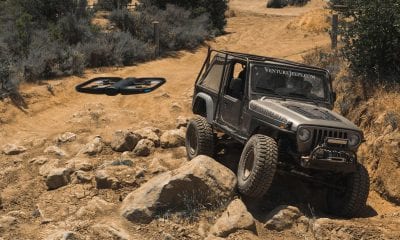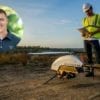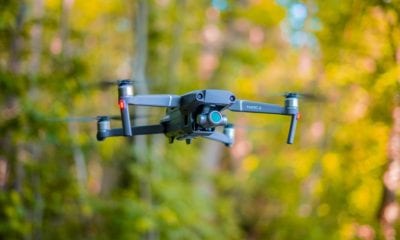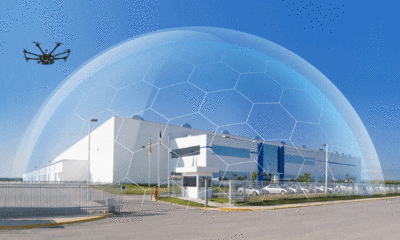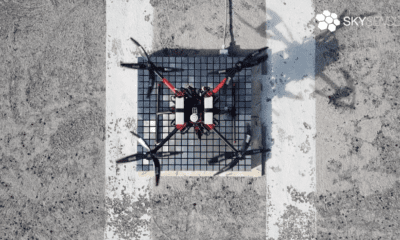Back to Base (B2B)
Flying High with Mykola Toptun, CEO of Skyeton, Ukraine’s Drone Leader
“Skyeton” is a Ukrainian company which provides full-scope unmanned aerial solutions both turnkey and customized as per client needs. Its focus is the development of highly automated aerial platforms, designed to operate continuously, over extended durations and distant environments. We reached out to the CEO Mykola Toptun for some insight into Skyeton.
Hi Mykola, thanks for taking the time to talk to us, first up can you please outline the vision behind Skyeton?
Our vision is developing and producing long-range automated aerial platforms, which can become a key solution for military and civilian needs and bring the market of unmanned aerial systems (UAS) to a new level.
How did the company first come about?
Skyeton was founded in 2006 by Ukrainian pilots and engineers as an aviation company that produced a light sport aircraft called the “K-10 SWIFT”. In 2015 the R&D process for the creation of unmanned aerial systems commenced. A wealth of Ukrainian experience in the aerospace arena and the conflict in the Eastern Ukraine pushed our company to enter the long-range UAV market.
Skyeton produces the manned K-10 SWIFT and the unmanned RAYBIRD-3, please tell us about the development of both products, were there RAYBIRD-1 & 2s ?
Let me just specify that currently we do not produce manned K-10 SWIFT, and have shifted our attention to unmanned systems, in particular the RAYBIRD-3. However, upon request we can provide technical support for those earlier models purchased prior.
Our UAV passed through the development process and modifications prior to been released as a RAYBIRD-3, where number “3” stands for aircraft wingspan. It is the first, but definitely not the last version of the product. RAYBIRD-1 & 2s are also included in the forthcoming plans, but the first step is to present an electric-powered RAYBIRD-3 which will guarantee higher performance characteristics due to its electric motor system.

What are some of the special performance capabilities of the RAYBIRD-3?
We are greatly concerned about safe aircraft performance and achieve this by means of the duplication of systems and vital elements providing total redundancy.
Our systems offer high endurance, resilience, high cruise speed, maximum automation, safety of payload due to aircraft flip over and retract mechanism.

What is RAYBIRD-3’s maximum range and flight time?
The flight time is up to 20 hours, which also may depend on the type of payload, the duration of its work during the flight and power consumption. The maximum possible range is around 2,500 km. I would like to mention here that the direct control is available at the range more than 200 km, i.e. when telemetry and control data is transmitted. Finally, Digital Data Link (DDL) is possible at range of up-to 100 km.
Personally I strongly believe that in the near future, thanks to technological progress, many standard on-ground vehicles will be replaced by aircraft, specifically unmanned aircraft. Long flight time won’t be considered as a vital parameter, since with the ability to take-off and land automatically, they will substitute each other in the air during missions. The application of a flying flotilla of Raybird-3 for the efficient mission completion is also included in our future plans.
5 kg of payload capability is quite impressive, what sort of instrumentation might be possible to carry?
Virtually all kinds of payloads can be attached. For instance, photo and video cameras are the most widely used payload types. The important restrictions are their weight, size and power consumption. We can integrate any payload up to 5 kg depending on the specific customer’s needs whether it is monitoring , data collection, crime scene investigation or search and rescue operations. Also, I would like to point out that apart from cameras, we are also ready to consider other types of payload (WiFi hotspots, light signals, mail, medicine, etc.) for various commercial applications.
Typically what industries is this UAV designed to serve?
Our system serves as a valuable and versatile tool for a wide range of applications for both defense and civilian missions. The UAV can create real value by patrolling large areas over extended periods. Application are literally endless: border control, anti-poaching, forestry and wildlife observation, SAR operations, wildfires prevention, expeditionary and ISTAR (intelligence, surveillance, target acquisition, and reconnaissance) tasks. Among the others are also pipeline management and detection (eg. leaks, surveying, security); power transmission line monitoring; monitoring of buildings and bridges for defects and damage; highway inspection; mapping and surveying.
How many units shipped to date?
Currently we have already sold a number of UAS to customers from various countries and purposes. Also, recently we signed and agreement with the The Ministry of Defence of Ukraine for the supply of our UAS to the Ukrainian Army.
Can you describe take-off and landing protocols with the RAYBIRD?
Firstly, it should be mentioned that takeoff and landing are completely autonomous and runway free, i.e. the UAV is not dependable on terrain type and does not require a prepared airfield.
After having the UAS unpacked and installed on a catapult, the engine is started-up and idled to allow it to warm up. At that moment the operators perform system checks, set up the route and assign the specific task. Also, at this stage the landing point is specified. As soon as a pre-flight check is completed, the operator presses the launch button on the ground control station and the bird launches into the sky.
When the assigned mission is completed, the UAV commences the landing process at the defined point, which starts with parachute and airbag deployment, which causes the aircraft to flip over. At the same time a retract mechanism is activated and the payload is stowed inside the aircraft’s belly so that any instrumentation is safe prior to landing, Finally the accuracy of landing is 30×30 m.
What type of fuel is used, are there battery options?
We use standard gasoline or mixed gas and two-stroke oil. Currently we are working on the integration of an electronic motor instead of fuel powered engine so that Raybird-3 can be offered as an environmentally-friendly solution, completely emission-free and of course much quieter.
What special features does the RAYBIRD-3 have that gives it a competitive advantage?
The RAYBIRD-3 have a significant advantage in terms of sophisticated design, speed, resilience, convenience and cost effectiveness over other UAVs and, certainly over more traditional solutions. Among the special features are:
- live telemetry data are available for instant monitoring
- unique safe recovery system;
- simplicity of assembly work, i.e. tool free assembly in order to eliminate human error;
- autonomous operation of the system, while maintaining dynamic position and altitude of aircraft.
And the price for a single RAYBIRD-3?
Since Skyeton’s main goal is to provide a solution for customer specific tasks, the price for the system is closely connected to a customer’s requirements. The whole system can comprise of a different number of UAVs as well as of other customized elements. Prior to taking an order we do our best to analyse accurately the customer’s needs, scale of works to perform and, afterward, make assessment.
Is RAYBIRD fully automated or can it be manually operated if required?
From the very beginning the goal was to eliminate human intervention while the aircraft is operating in order to diminish the risk of accidents. As a consequence, we have created a fully automated UAV – Raybird-3. Certainly, some slight changes or, let’s say corrections, such as altering the flight course, altitude, speed are allowed within reasonable limits.
In the future, what other industries might RAYBIRD serve and why?
Raybird may represent a whole host of opportunities across many different industries. In my opinion the next important industries where UAV application rises and will continue to play a vital role are:
- Logistics market: by providing rapid parcel delivery, which also will also increase the overall safety and efficiency of the transportation process.
- Insurance industry: UAVs makes it possible to conduct fast and precise post-disaster collection which in its turn simplifies the insurance inspector’s work .
- Medical deliveries: UAVs can be implemented as a logistic method since they enable the safe and reliable delivery of drugs and medical samples to remote areas.
- Communication services: Raybird-3 will become a solution for the achievement of a high-rate data transmission.
Any plans for RAYBIRD-4 or other UAV models?
As mentioned previously, we currently working on a Raybird-3 with an electric engine, for which the flight time won’t be as long as petrol, but it will be more simple to maintain it and use it, for some customers this is critical.
Does Skyeton see any potential in the consumer sector with other small fixed wing products?
Soon we will announce Raybird-2, which is going to be a scaled-down version with a 2 meters wingspan and fully electric. Flight-time will be shorter but performance and ease of use will be first-class and importantly offered at a much more lower price. We believe it will open new possibilities for industry and consumers by providing professional tools at a lower price.
Where do you think the UAV market will be in the next 10 years?
With the UAV market rapidly evolving with an ever-expanding list of UAVs application in commercial sectors, more and more businesses, governments and NGOs will recognise the value of UAVs and what they can bring to their organisations.
As unmanned air traffic grows, we fully expect to see flotillas of UAVs, once strong regulatory frameworks are established. Also, unmanned air-traffic-management (UTM) systems will be set up, which will enable safe, low-altitude flight of UAVs within national airspace. Thus, the communication between UTM systems and air-traffic-control (ATC) systems for commercial aircraft will be established and that will make high-altitude flights beyond visual line-of-sight viable and safe.
Finally, in terms of technological boom, there is no doubt that the UAS will become totally automated, and more investment and efforts will be directed to the development of software and the UAV ecosystem to improve UAS operations.
Finally, Mykola, anything else you’d like to add?
I would like to announce that our company takes part in the largest, most comprehensive trade show for unmanned and autonomous systems – AUVSI XPONENTIAL 2019, which will be held in at McCormick Place in Chicago from April 29 to May 2. That is a good opportunity for us to present Raybird-3 to the vast majority of the entire unmanned systems community.
About Mykola Toptun, CEO of Skyeton
 Currently, Mykola Toptun is a director of APC Skyeton and chief designer of the Raybird-3. His love for aero-modelling started when was a twelve year old and over the years turned into a professional activity. Mykola took part in military operations against Russian invaders in 2014 when an armed conflict in the Donbass region of Ukraine arose. During that period he gained practical experience and understanding of the way UAVs should work and their potential applications. Thus, the common idea and vision united pilots and engineers who brought to life the Raybird-3 highly automated aerial platform.
Currently, Mykola Toptun is a director of APC Skyeton and chief designer of the Raybird-3. His love for aero-modelling started when was a twelve year old and over the years turned into a professional activity. Mykola took part in military operations against Russian invaders in 2014 when an armed conflict in the Donbass region of Ukraine arose. During that period he gained practical experience and understanding of the way UAVs should work and their potential applications. Thus, the common idea and vision united pilots and engineers who brought to life the Raybird-3 highly automated aerial platform.








